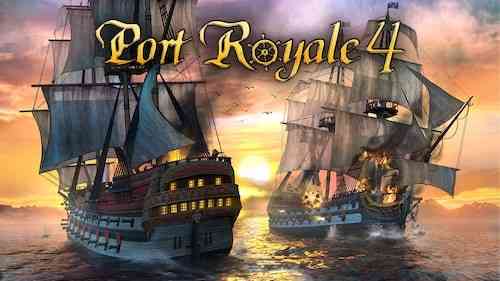Port Royale 4 Review
If the events of 2020 have ruined your grand travel plans for the year, perhaps a trip to the sunny Caribbean is in the cards for you. Port Royale 4 offers a particularly unique opportunity to escape to paradise if, of course, your idea of vacation includes building plantations, poring over trade routes, and fighting pirates. Port Royale is a series of trading simulation and strategy games where you compete with other nations to dominate the Caribbean by establishing successful trade and maintaining profitable cities. The newest addition to this early-2000s series is beautiful and expansive, with new turn-based naval battles and a decent number of construction projects that expand the city-building elements, but it, unfortunately, falls short in keeping the gameplay engaging or addicting.
All Aboard
In Port Royale 4, you have the option to play as Spain, England, France or the Netherlands in your 17th-century Caribbean conquest. Each nation has its own lengthy campaign, but there is also a Free Game mode with widely customizable settings for anyone who wishes to go their own way. Getting the hang of gameplay can be quite challenging at first, and though the tutorials take about an hour or more to complete, it’s still pretty easy to get lost once you’re thrown out to sea thanks to the range of different mechanics.
Most of the gameplay takes place in a large overhead map that allows you to quickly pan from one city to another and follow along with the many ships that occupy the waters, but you can also zoom in close enough to any city to see the breadth of daily life. There’s not too much to observe; you won’t see people buzzing around or going about their routines the way they do in say, Tropico, but there is still a decent amount of detail in the buildings that can be admired.
The bulk of your time is spent buying or ordering the construction of new ships, all of which are modeled after historic 16th and 17th century vessels, creating and managing trade routes, and building new farms, residences, or infrastructure in your cities. You must manually sail around to discover new cities on the map, purchase permits to trade with each of them, and apply for permits in order to build construction projects anywhere outside of your home city.
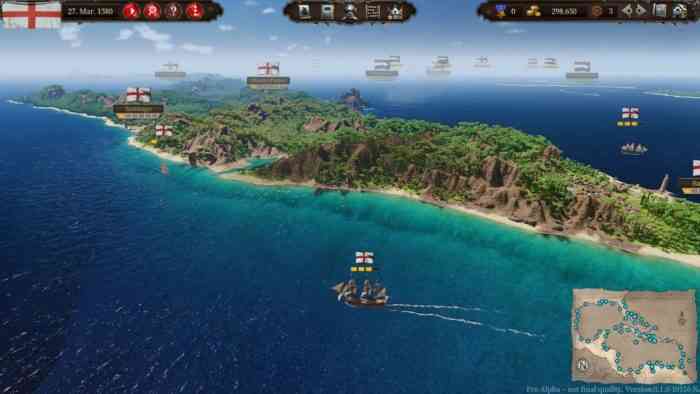
Additionally, you can perform tasks for different nations or for the Viceroy of your own, which usually consist of delivering a certain amount of goods in a designated time frame or patrolling an area of the sea to look for missing persons. Performing tasks, combined with establishing consistent trade, rewards you with Fame points that can be used to unlock perks throughout the game.
Fair Trade
Trade is the primary focus of Port Royale 4, and it can feel daunting at first. However, after enough fumbling around, you’ll come to discover that it’s actually easier than it seems thanks to some of the game’s auto settings. Each city can only produce up to seven different commodities (out of a possible 25) and it’s up to you to facilitate distribution to ensure that every city gets enough of each resource. Resources span four different categories: Basic goods, which include things such as wheat, fruits, vegetables and wood, demanded goods like hemp, meat, and coal, export and craft goods such as clothing, coffee and tobacco, and quality goods like pastries and furniture. The citizens in each city appreciate having access to all of these goods, and become unhappy when there isn’t a constant flow of variety and supply.
To establish a trade route, you need to assign individual ships to convoys, or groups of vessels that carry out tasks together. Ships will simply sit in your shipyard doing nothing if you do not assign them to a convoy, which you must do at the town’s Lighthouse. Moving ships to a brand new convoy is easy enough, but trying to add a ship to an existing convoy is a bit clunky: All ships must be parked in front of the Lighthouse before you can add a new one to the group, which means a great deal of time is spent hovering around the ocean to find the correct ships just to disrupt their tasks and recall them home for a second.
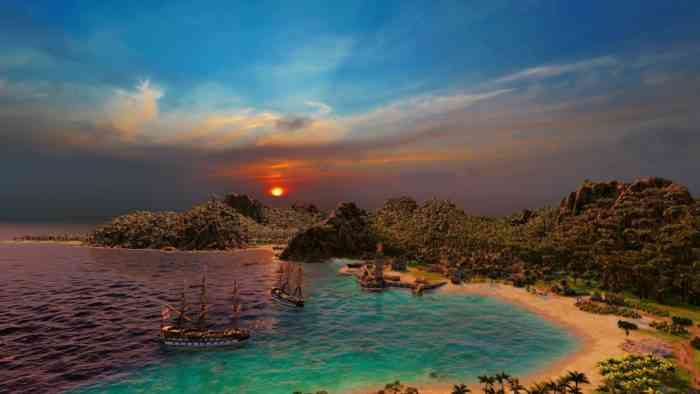
Once you have convoys out on the water, you can set up trade routes between any number of cities you have purchased trade permits from. Unless you assign the Merchant perk to your main character at the start of the campaign, you cannot trade with hostile cities or cities with whom you are at war. When setting up trade routes, a preview of the path your ships will take appears, along with an estimate of how many days the full route will take to complete. The path can be adjusted by clicking and dragging it around the ocean, which can allow you to use wind directions and sea conditions to your advantage. Having to pay attention to wind patterns and avoiding things such as shallow reefs that can slow your ships down seems to add complexity to the game on its surface, but in reality, it doesn’t feel as though it really matters that much. You can tweak your route all day until you’ve found the swiftest possible path, but when you’re overseeing an entire Caribbean nation with a handful of trade routes that are constantly active, you’ll rarely notice the financial benefit gained from shaving a couple days off your routes.
While you have the option to manually adjust the individual goods you exchange when editing trade routes, I learned the hard way that you can instead set the game to automatically trade with each city for you according to the supply and demand of every destination. Once I figured this out in a runthrough of my first campaign, I no longer ran into financial problems, and it felt as though the game began to play itself. With less than ten trade routes active, I began to see my funds run well into the millions, which effectively took away all of the challenge of the game. Having fully automated trade routes made the game far too easy, as much of the campaigns revolve around buying new construction projects and funneling the necessary building resources into those projects. With enough money in the bank, you can place any building you desire, sit back with the game’s speed on the fastest setting, and just watch it all happen. Building resources will inevitably make their way into town if you have trade routes running through it, requiring virtually no interference from you. It’s a shame, really, that when this happens the game becomes little more than watching a bunch of boats sail around in a circle.
Pillage and Plunder
One thing that can spice up the gameplay if you’re playing a Free Game or a more challenging campaign is a good, old-fashioned naval battle. Depending on your starting settings or your campaign, other nations will declare war on you quite frequently — or certain captains will just single you out and pick a fight. If you have a warship (as opposed to a mere merchant vessel), you can either let the battle play out automatically or roll up your sleeves and go in yourself. Battles are turn-based, with each ship having a different set of action and maneuver points. Not only do you have to move your vessel around the grid, but you must also use maneuver points to adjust your ship’s orientation to allow for the cannons on both sides to hit the enemy’s ships dead-on. There are a couple of ammo types for the cannons that inflict different types of damage, as well as a Boarding option that sends your sailors to storm an enemy’s deck, thus disabling the use of either ship. By performing tasks throughout the game, you can also earn Tactics, which are special abilities or power-ups that can be applied during battle.

Manual naval battles require a bit of care to win, but it’s not too complicated for players who are new to turn-based strategy to grasp. The strategy elements aren’t particularly complex, and in some ways, it can be more challenging to acquire strong warships than to fight with them.
If you refuse a battle or simply don’t have a vessel equipped to fight one, the enemy will either seize your ship entirely or plunder any cargo you have onboard. It can take quite a while to unlock enough Captains to command a warship, which cannot sail on the water without one. Captains are unlocked with Fame points, and can be leveled up and assigned different skills such as increasing the speed of a ship or granting extra maneuver points in battle. The process of building Fame, purchasing and strengthening ships, and unlocking Captains can take time at first, meaning you won’t feel equipped to fight a naval battle for at least a little while.
Muddy Waters
Port Royale 4 has a few core elements that sound great on paper, but they all show weakness in their own ways. Naval battles are pleasant, but certainly not anything to write home about. I would have liked to feel more badass with more exciting explosions and animations or even more grandiose music, but these are just minor missed opportunities. Trade routes masquerade as if they are sensitive to the player’s choices, but in truth, if you just click on a few cities and haphazardly set the exchanges to automatic, you’re most likely going to keep your funds in the black. The same goes for ramping up resource production and building out your cities. You can plant new farms and set up new factories all you want, but at a certain point, this won’t even feel necessary. Once you have enough money to purchase anything you want without worry, there’s little left to work towards besides a stronger war fleet.
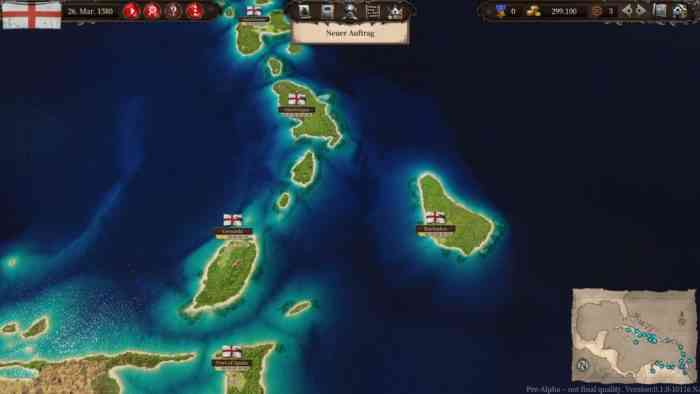
The city-building is rather unstimulating and offers almost no interaction with individual buildings on a micro level. Placing farms, production facilities and municipal establishments feel more like a side chore than a project to get excited about, and while balancing the job market and the availability of living spaces for citizens can be tricky, the needs of the citizens themselves hardly seem to matter.
In truth, much of the content in Port Royale 4 feels like it doesn’t matter. I rarely felt the impact of my actions outside of battle, and barely felt the need to please my citizens. It’s extremely easy to make them happy as long as you set up a few trade routes that frequent your town, because the only thing they seem to care about is the influx and variety of new resources. You can place parks and hospitals and bars around their homes to make them happy, but again: It doesn’t really seem to matter.
Nothing Really Matters, Anyone Can Sea…
All of this is not to say that Port Royale 4 is a bad game. It’s beautiful, polished and large in scope, and Free Games can offer unending gameplay. It’s no doubt that certain players will get a rewarding experience out of this game, but I found the pacing to be too slow — and the incentives to be too low — to merit long hours of play. I didn’t feel that my choices mattered, nor did I really have any attachment or investment to the goals set in place for me. In one campaign, dominating the Caribbean didn’t even cross my mind. I was fairly left alone by other nations, and there was no urgency or need to ramp up my production to ultra high levels or expand my power to more cities. I would have enjoyed the game more if it pushed me or offered more reward or complexity, but perhaps players who don’t mind being given less direction will consider this a non-issue.
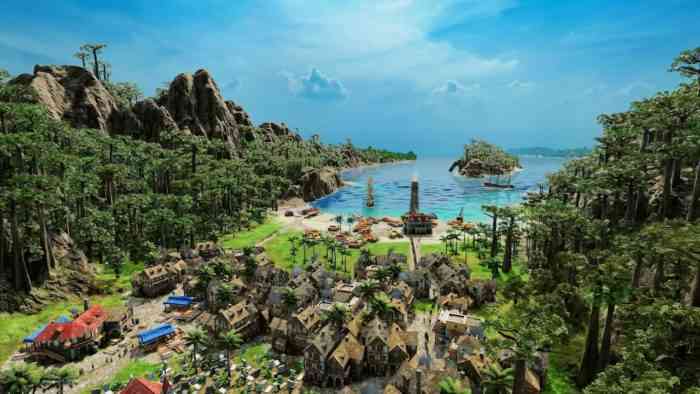
Overall, Port Royale 4 lends beautiful design to its historical ships and detailed buildings, and the turn-based strategy naval battles are a nice change of pace from the large, lulling overview map you will spend most of your time in. The game can be as stressful or as peaceful as you want it to be depending on how you adjust the settings of your Free Games or how you approach certain campaigns, but it would be nice if it were weighted more heavily with decision making or rewards and consequences. While I found the auto-trade settings to make the game far too easy and hands-off, you can always make your life more difficult and toggle resource exchanges manually.
Lovers of city-building will be left unsatisfied because it plays a more minor (and less interesting) role in the game than one would hope, but I would recommend Port Royale 4 to fans who have played the series before or for those who love a mix between resource management and strategy. For anyone else who falls somewhere in between, I may recommend that you wait for a price-drop.
***PC review code provided by the publisher.***
The Good
- Ships and buildings look great
- Free Games offer a lot of game time
- Decent mix of strategy and trade
The Bad
- Slow paced
- Low reward or incentive
- Many things will be learned the hard way
- Nothing really matters
